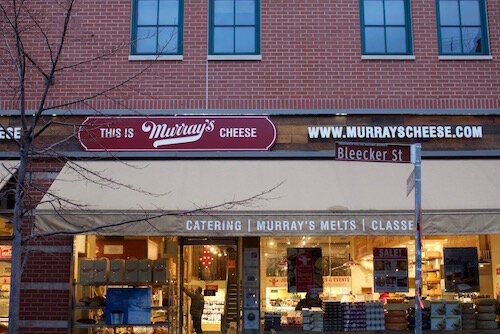Cheese Shops We Love: Murray’s Cheese
Location:
Murray’s Cheese
254 Bleecker St, New York, NY 10014
Murray's storefront
Murray’s Cheese — one of the first shops in the US to import a variety of European cheeses and champion small-scale American cheesemakers — has a long history in New York City’s Greenwich Village.
A Long History in Cheese:
“The deep roots of Murray’s are mired in the mystery of oral tradition,” says Elizabeth Chubbuck, Murray’s SVP of Sales. What the staff knows for sure is that the shop was originally founded in 1940, by Murray Greenberg, a Jewish immigrant and a veteran of the Spanish Civil War. Greenberg sold eggs and butter (a common business at the time) out of a smaller spot kitty-corner to the current flagship store. In the 1970s, Greenberg sold the shop to his head clerk, Louis Tudda, who transformed it into an Italian specialty store. “The story goes that Louis would scour the wholesale markets at the end of the day to find the best deals on things that had been picked over,” says Chubbuck.
In 1991, Rob Kaufelt, the son of a New Jersey-based grocer, purchased the shop from Tudda. At the time, most Americans didn’t have access to high-quality or small-batch cheeses. Very few fine European cheeses were being imported, and most American farmstead cheeses were only sold at local markets. Kaufelt traveled around Europe and began direct-importing a variety of unique specialty cheeses for his New York customers. The business flourished, and in 2000, Kaufelt moved to the larger spot that is still Murray’s flagship location and built cheese caves into the basement (on the advice of a French affineur in Roanne). Today, the staff at Murray’s ages a variety of cheeses—experimenting with different kinds of rinds, wraps, and seasonings—to give their customers access to even more unique offerings.
The Store:
Murray’s flagship store, on Bleeker Street, sells a wide variety of imported European cheeses, small-batch American farmstead cheeses, and cheeses that the staff purchases from producers and then ages in the store’s caves. The shop also offers a tasting salon, a classroom, and a well-stocked shop that sells not only cheese and cheese accompaniments but also a variety of other ingredients and foods, from tinned fish and charcuterie to pastas and sauces (and a very small, seasonal selection of produce). “It’s basically cheese and meat and everything you want to eat with those things,” says Chubbuck, “and a selection of high-end ingredients that allow you to take the cheese and meat and turn it into a meal.”
The long cheese counter takes up an entire wall of the store. In other areas, customers will find cases full of meats and prepared food, pre-packaged cheeses, and yogurts, ice creams, and butter; a floor-to-ceiling selection of crackers; a broad array of jams and honey; a selection of beer and cider; coffee from roasters across the country; and pasta, oils, vinegar, and sweets. The back of the shop houses the classroom.
Top-Selling Cheeses:
Murray’s Burrata
Burrata’s mild, milky flavor has made it a favorite ever since Murray’s first started selling it. At the time, the mozzarella-like cheese with a creamy center had to be imported from Italy, which meant that it had a very short shelf-life once it arrived in the U.S. and had to be eaten within a couple of days. (Chubbuck notes that the fact that the cheese aged a bit while it shipped meant that for years, American chefs and consumers expected burrata to have a slightly soured flavor.) Chubbuck also posits that, in the age of viral recipes, burrata may also benefit from its Instagram-friendly looks and form factor.
Parmigano Reggiano
“Real Parmigiano Reggiano is the king of cheeses,” says Chubbuck, who also calls it “the ultimate pandemic life cheese.” She credits its popularity to parmigano’s strong flavor, long shelf life (in the refrigerator), and versatility, pointing out that it works well on everything from chicken to pasta to vegetables. She also notes that it makes an excellent snack, on its own or with some prosciutto, crusty bread, and olive oil.
Roomano Extra Aged Gouda
This firm cows’ milk cheese from the northern Netherlands is typically described as a 3-year-aged Gouda but is lower in butterfat. (Cheeses must have 48% butterfat to be classified as a Gouda.) “Roomano is one of the most widely appealing cheeses I have ever met,” says Chubbuck. “Dense and crunchy with notes of butterscotch and scorched milk, this cheese pleases everyone from kids to grandparents.”
Also Look For:
Murray’s flagship store is known for its many cheese-focused classes. Their in-store classroom hosts cheese tastings, pairing classes, cooking demonstrations, and hands-on workshops that teach students skills like making fresh mozzarella or assembling a cheese board. There are also weekend boot camps for “curd nerds” to dive into the science of cheese making. (All classes are currently virtual.)




